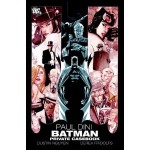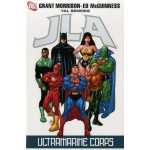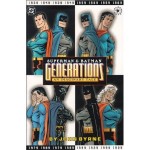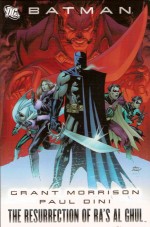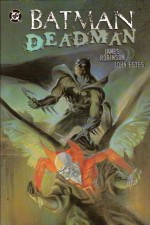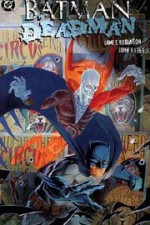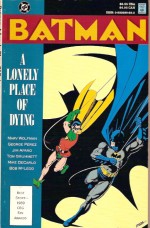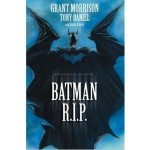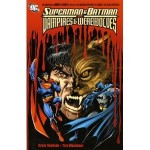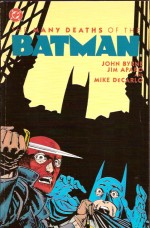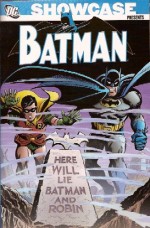
By Frank Robbins, Irv Novick, Bob Brown, Joe Giella & various (DC Comics)
ISBN13: 978-1-84856-357-5
After three seasons (perhaps two and a half would be closer) the overwhelmingly successful Batman TV show ended in March, 1968. It had clocked up 120 episodes since the US premiere on January 12, 1966. As the series foundered and crashed the global fascination with “camp†superheroes – and no, the term had nothing to do with sexual proclivities no matter what you and Mel Brooks might think about Men in Tights – burst as quickly as it had boomed and the Caped Crusader was left with a hard core of dedicated fans and followers who now wanted their hero back.
For the editor who had tried to keep the most ludicrous excesses of the show out whilst still cashing in on his global popularity, the reasoning seemed simple: get him back to solving baffling mysteries and facing genuine perils as soon and as thrillingly as possible.
No problem.
This fourth impressively economical black and white compendium gathers Batman and Robin yarns from Batman #202-215 and the front halves of Detective Comics #376-390; the back-up slot being delightfully filled until #383 by the whimsically wonderful Elongated Man, whereafter he was unceremoniously dropped to make room for Batgirl’s own solo sallies.
The 27 stories here (some of the Batman issues were giant reprint editions so only their covers are reproduced within these pages) were written and illustrated by an evolving team of creators as editor Julie Schwartz lost some of his elite stable to age, attrition and corporate pressure, but the “new blood†was only fresh to the Gotham Guardian, not the industry and their sterling efforts deftly moulded the character into a hero capable of actually working within the new “big things†in comics: suspense, horror and the supernatural…
The book leads off with ‘Gateway to Death!’ (Batman #202, June 1968) by Gardner Fox, an un-attributed artist – possibly Dick Dillin or Mike Sekowsky – & Sid Greene, a spooky graveyard chiller which found the Dynamic Duo chasing a psychic plunderer towards their own prognosticated doom, after which Detective #376 (by the same creative team) asked ‘Hunted or …Haunted?’ as a time-traveller inadvertently put the fear of death and worse into the Caped Crusader.
Batman #203 was an 80-Page Giant with a cover by Neal Adams, whilst an old foe returned in ‘The Riddler’s Prison-Puzzle Problem!’ (Detective #377, Fox, Frank Springer & Greene) before Frank Robbins (creator of newspaper strip Johnny Hazard) joined the writing team for ‘Operation: Blindfold!’ illustrated by Irv Novick & Joe Giella, a two-part criminal conspiracy saga wherein a legion of thugs and sightless beggars almost took over Gotham.
With veteran penciller Bob Brown on Detective and Novick on Batman the artistic quality was high and consistent but unfortunately the strictly chronological reprinting works against the reader as the concluding episode is postponed and derailed here by Detective #378, the first half of a generation gap murder-mystery ‘Batman! Drop Dead… Twice!’ (Robbins, Brown & Giella) which itself climaxed after ‘Blind as a… Bat?’ from Batman #204 with a rollicking rollercoaster ride of spills and chills in ‘Two Killings For the Price of One!’ in Detective #379.
Issue #380 follows, introducing a new love-interest in Ginny Jenkins, the ‘Marital-Bliss Miss!’ (Robbins, Brown & Giella) who only pretended to be the new Mrs. Bruce Wayne for the very best of motives – saving his life – whilst in Batman #206 Novick & Giella illustrated a canny thriller ‘Batman Walks the Last Mile!’ pitting the Caped Crusader against a conman who claimed to be the brains behind the Dynamic Duo’s success.
In an era where teen angst and the counter-culture played an increasingly strident part Robin’s role as spokesperson for a generation was becoming increasingly important, with disputes and splits from his senior partner constantly recurring. Detective #381 featured one of the best as Batman literally dumped the Boy Wonder in ‘One Drown… One More to Go!’ – another clever crime conundrum from Robbins, Brown & Giella.
Batman #207 carried a classy countdown to catastrophe drama as all Gotham hunted for ‘the atomic nightmare’ of ‘The Doomsday Ball!’ whilst ‘Tec #382 continued the theme of youth in revolt with ‘Riddle of the Robbin’ Robin!’ but the disagreements were never serious or genuine, although that would soon change. Batman #208 was another reprint Giant: this time focusing on the women in his life. However even though Schwartz varied the usual format by having Gil Kane draw interlocking framing sequences, turning the issue into one big single story, all that has all been left out here so you just get the rather nifty Nicky Cardy cover.
Detective #383 was a straightforward thriller set in Gotham’s Chinatown: ‘The Fortune-Cookie Caper!’ but outlandish mind-bending mystery was the order of the day in ‘Jungle Jeopardy!’ in Batman #209 and ‘Tec #384 asked ‘Whatever Will Happen to Heiress Heloise?’ a crafty last tale of cross and double-cross from Gardner Fox, illustrated as ever by Brown & Giella.
Catwoman returned mob-handed – or is that mob-pawed? – in Batman #210 with eight other cat chicks in tow so the Caped Crimebuster was hard-pressed to solve ‘The Case of the Purr-Loined Pearl!’ whilst Bob Kanigher wrote one of the best tales of his long and illustrious career for Detective #385 as a nameless nonentity became the most important man Batman never met in the deeply moving ‘Die Small… Die Big!’
Issue #386 found Bruce Wayne a ‘Stand-In for Murder’ (Robbins, Brown & Giella) whilst the heroes had secret identity woes in ‘Batman’s Big Blow-Off!’ (#211, (Robbins, Novick & Giella) and Young Turk Mike Friedrich returned to script a reworking of Batman’s very first appearance for the 30th Anniversary issue of Detective Comics. ‘The Cry of Night is… Sudden Death!’ was a contemporary reworking of issue #27’s ‘The Case of the Chemical Syndicate’ which launched the Dark Knight on the road to immortality (and to see the original check out Batman Chronicles Volume 1, or any of the many “Best of†collections that feature this landmark tale) but once more the relationship between Batman and Boy Wonder came under probing scrutiny.
‘Baffling Deaths of the Crime-Czar!’ (Batman #212, Robbins, Novick & Giella) pitted a trio of exuberant hit-men against the heroes, before John Broome made a final scripting contribution that moved the Joker away from Clown crimes and back towards the insane killer we all cherish in ‘Tec #388’s ‘Public Luna-tic Number One!‘Â – a classy sci-fi thriller that totally reinvented the Laughing Loon, in no small part thanks to the artistic efforts of Brown & Giella.
Batman #213 was another reprint Giant, celebrating other landmarks of the 30th Anniversary and featured a new retelling of ‘The Origin of Robin’ courtesy of E. Nelson Bridwell, Ross Andru & Mike Esposito, which is included here after the spiffy cover from Bill Draut & Vince Colletta.
The road to a scary hero continued with Detective #389 and the Robbins-scripted ‘Batman’s Evil Eye’ wherein the Scarecrow infected Gotham’s Guardian with the power to terrify at a glance – obviously somebody saw the long-term story potential in that stunt…
There was still potential to be daft too, though as seen in ‘Batman’s Marriage Trap!’ (#214, Robbins, Novick & Giella) wherein a wicked Femme Fatale set the unhappy spinsters of America on the trail of Gotham’s Most Eligible Bat-chelor (see what I did there? Wishing I hadn’t…?) Not even a guest-shot by positive role-model Batgirl can redeem this peculiar throwback – although the art just might…
The last Detective tale is from #390 and pits the Dynamic Duo against lacklustre costumed assassin The Masquerader in ‘If the Coffin Fits… Wear It!’ before the end of an era is presaged in Batman #215 and ‘Call Me Master!’ by Robbins, Novick and the soon to become legendary Dick Giordano. Although a clever tale of mind-control skullduggery, this tale trialed the loss of Wayne Manor and an all-out split between Dark Knight and Boy Wonder: events that would come to pass within mere months, ushering in a bold new direction for the Bat-Universe
This volume brings three decades of Batman to a solid conclusion. Soon safe boy-scout Caped Crusader would become a terrifying creature of passion, intellect and shadowy suspense.
Stay tuned: This book is wonderfully good but the very best is still to come…
© 1968, 1969, 2009 DC Comics. All rights reserved.

